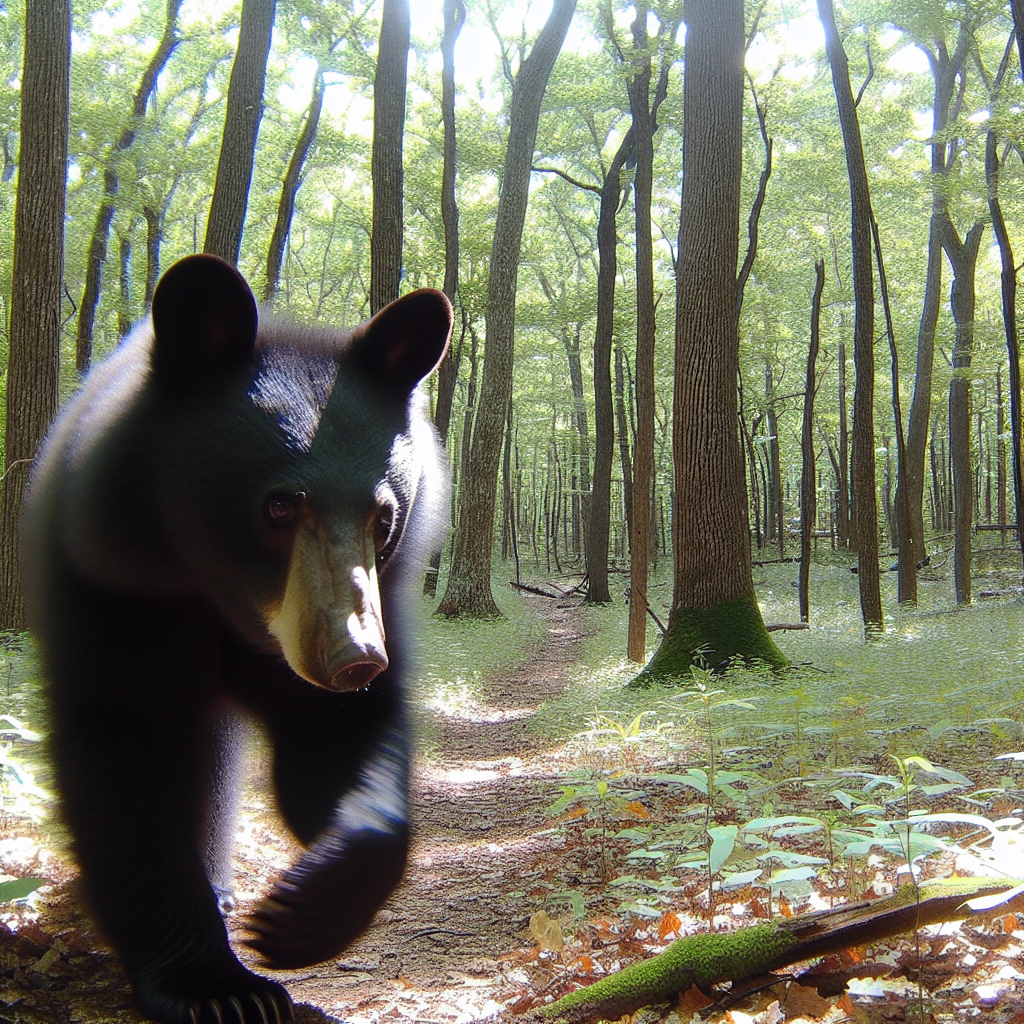IDNR Monitoring Black Bear Sightings in Southwestern Illinois: What You Need to Know
Published by giant.fm | Last updated: June 2024
Introduction: Black Bear Sightings on the Rise in Southwestern Illinois
In recent months, residents of Southwestern Illinois have reported an increase in black bear sightings, sparking both curiosity and concern among local communities. The Illinois Department of Natural Resources (IDNR) has responded by intensifying its monitoring efforts to ensure public safety and the well-being of these majestic creatures. According to a recent report by giant.fm, the IDNR has confirmed multiple sightings and is actively tracking the movements of black bears in the region.
As black bears return to Illinois after more than a century of absence, understanding their behavior and how to coexist safely is crucial. This article explores the latest developments in black bear monitoring by the IDNR, what it means for residents—especially those with food sensitivities and dietary preferences—and how technology like Food Scan Genius and Yuka can help keep your family and your food safe.
Why Are Black Bears Returning to Southwestern Illinois?
Black bears (Ursus americanus) were once native to Illinois but disappeared from the state by the late 1800s due to habitat loss and unregulated hunting. In recent years, however, there has been a gradual return of these animals, primarily due to successful conservation efforts in neighboring states and improved habitat conditions in Illinois. According to the IDNR, most of the recent sightings involve young male bears dispersing from Missouri and Arkansas in search of new territory.
The resurgence of black bears in Illinois is a testament to regional wildlife management success, but it also presents new challenges for communities unaccustomed to living alongside large mammals. The IDNR is committed to monitoring bear activity to protect both the animals and the public.
IDNR’s Response: Monitoring and Public Education
The Illinois Department of Natural Resources has established a comprehensive protocol for tracking black bear sightings. Using a combination of public reports, trail cameras, and field investigations, IDNR biologists are mapping bear movements and identifying potential conflict areas. Residents are encouraged to report any sightings directly to the IDNR to aid in these efforts.
- Public Reporting: Residents can report sightings via the IDNR website or hotline, providing details such as location, time, and bear behavior.
- Field Investigations: Wildlife biologists investigate reported sightings to confirm bear presence and assess risks.
- Educational Outreach: The IDNR is distributing information on how to safely coexist with black bears, including securing food sources and avoiding direct encounters.
The giant.fm article highlights the importance of community involvement in tracking and managing these sightings.
Black Bears and Food: What Residents Need to Know
Black bears are highly food-motivated animals, and their presence near human settlements is often linked to the availability of easy food sources. This includes unsecured garbage, bird feeders, pet food, and even compost piles. For people with food sensitivities and dietary preferences, the presence of bears introduces unique concerns about food storage and safety.
Safe Food Storage Tips for Bear Country
- Store all food indoors or in bear-resistant containers.
- Clean outdoor grills and remove food scraps promptly.
- Feed pets indoors and avoid leaving pet food outside.
- Use wildlife-proof compost bins and avoid composting meat or dairy products.
- Bring bird feeders indoors at night or during bear activity peaks.
For those with food allergies or dietary restrictions, cross-contamination from wildlife can be a concern. Bears rummaging through outdoor food supplies may inadvertently contaminate surfaces or containers, making it essential to maintain strict food hygiene.
Recent Research: Wildlife, Food Sensitivities, and Dietary Preferences
A 2023 study published in the journal Food Safety and Environmental Health found that wildlife incursions into residential areas can increase the risk of foodborne pathogens and allergen exposure, especially for individuals with compromised immune systems or severe food allergies. The study recommends heightened vigilance in food storage and preparation in areas experiencing increased wildlife activity.
Another 2024 report from the University of Illinois Extension emphasizes the importance of community-wide participation in wildlife management, noting that proper food storage not only protects residents but also discourages bears from becoming habituated to human food, reducing the likelihood of dangerous encounters.
How Food Scan Genius and Yuka Can Help
With the rise of technology in food safety, apps like Food Scan Genius and Yuka are becoming increasingly relevant for residents in bear-prone areas. These apps allow users to scan barcodes on food products to instantly access information about allergens, ingredients, and nutritional content.
- Food Scan Genius: Helps users identify hidden allergens and cross-contamination risks, which is vital when wildlife may have accessed outdoor food supplies.
- Yuka: Offers detailed product analysis, enabling users to make informed choices about food storage and consumption, especially for those with dietary preferences or sensitivities.
By integrating these tools into daily routines, families can better manage their food safety and reduce the risk of allergic reactions or dietary conflicts, even in the face of increased wildlife activity.
Bear Safety: What to Do If You Encounter a Black Bear
While black bears are generally shy and avoid humans, encounters can happen, especially as they explore new territories. The IDNR recommends the following safety tips:
- Remain calm and do not approach the bear.
- Make yourself look larger by raising your arms and speaking in a firm voice.
- Back away slowly and avoid turning your back on the bear.
- Never run from a bear, as this may trigger a chase response.
- Report the sighting to the IDNR as soon as possible.
For more detailed guidance, refer to the giant.fm article and the official IDNR website.
Community Involvement: How You Can Help
The successful management of black bear sightings in Southwestern Illinois depends on active community participation. Here’s how you can contribute:
- Report Sightings: Provide accurate information to the IDNR to help track bear movements.
- Secure Food Sources: Follow best practices for food storage and waste management.
- Educate Others: Share information about bear safety and food hygiene with neighbors, especially those with food sensitivities.
- Stay Informed: Monitor updates from the IDNR and local news outlets like giant.fm for the latest developments.
Frequently Asked Questions (FAQ) About Black Bears in Illinois
- Are black bears dangerous to humans?
- Black bears are generally not aggressive toward humans and prefer to avoid contact. However, they may become bold if they associate people with food. Proper food storage and avoidance of direct encounters are key to safety.
- What should I do if I find bear tracks or scat on my property?
- Report the evidence to the IDNR and take steps to secure all food sources. Avoid touching or disturbing the tracks or scat.
- Can black bears transmit diseases through food contamination?
- While rare, bears can introduce pathogens to food supplies if they access them. This is particularly concerning for people with food sensitivities or compromised immune systems. Always discard any food that may have been contaminated by wildlife.
- How can I use Food Scan Genius or Yuka to improve food safety?
- Both apps allow you to scan products for allergens and contamination risks, helping you make safer choices and avoid accidental exposure to problematic ingredients.
Conclusion: Coexisting with Black Bears in Southwestern Illinois
The return of black bears to Southwestern Illinois marks an exciting chapter in the state’s natural history, but it also requires vigilance and adaptation by local communities. The IDNR’s proactive monitoring, combined with public participation and modern food safety tools, ensures that both people and bears can thrive.
For residents with food sensitivities and dietary preferences, understanding the risks and taking advantage of resources like Food Scan Genius and Yuka can help maintain a safe and healthy environment. Stay informed, stay prepared, and embrace the opportunity to coexist with Illinois’ returning wildlife.
For the latest updates on black bear sightings and safety tips, visit giant.fm and the Illinois Department of Natural Resources.





